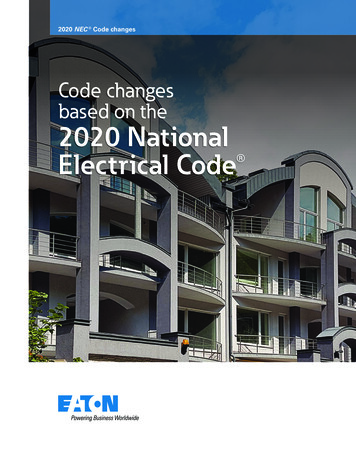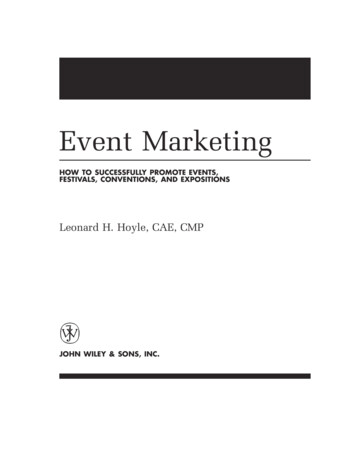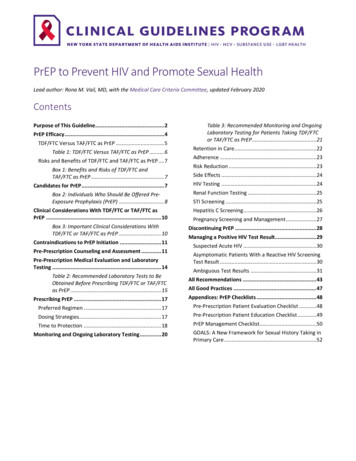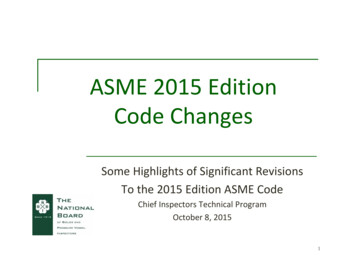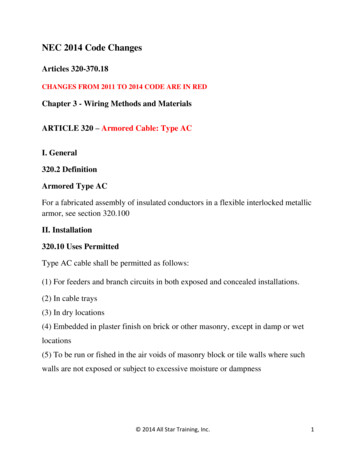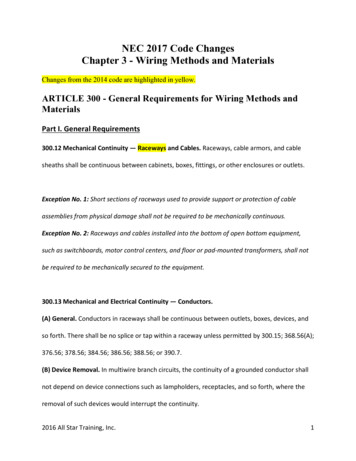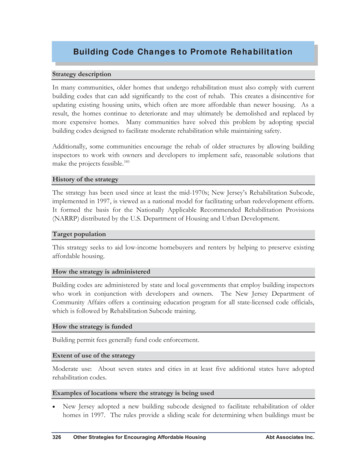
Transcription
Building CodeCode ChangesChanges toto PromotePromote RehabilitationRehabilitationBuildingStrategy descriptionIn many communities, older homes that undergo rehabilitation must also comply with currentbuilding codes that can add significantly to the cost of rehab. This creates a disincentive forupdating existing housing units, which often are more affordable than newer housing. As aresult, the homes continue to deteriorate and may ultimately be demolished and replaced bymore expensive homes. Many communities have solved this problem by adopting specialbuilding codes designed to facilitate moderate rehabilitation while maintaining safety.Additionally, some communities encourage the rehab of older structures by allowing buildinginspectors to work with owners and developers to implement safe, reasonable solutions thatmake the projects feasible. 181History of the strategyThe strategy has been used since at least the mid-1970s; New Jersey’s Rehabilitation Subcode,implemented in 1997, is viewed as a national model for facilitating urban redevelopment efforts.It formed the basis for the Nationally Applicable Recommended Rehabilitation Provisions(NARRP) distributed by the U.S. Department of Housing and Urban Development.Target populationThis strategy seeks to aid low-income homebuyers and renters by helping to preserve existingaffordable housing.How the strategy is administeredBuilding codes are administered by state and local governments that employ building inspectorswho work in conjunction with developers and owners. The New Jersey Department ofCommunity Affairs offers a continuing education program for all state-licensed code officials,which is followed by Rehabilitation Subcode training.How the strategy is fundedBuilding permit fees generally fund code enforcement.Extent of use of the strategyModerate use: About seven states and cities in at least five additional states have adoptedrehabilitation codes.Examples of locations where the strategy is being usedx326New Jersey adopted a new building subcode designed to facilitate rehabilitation of olderhomes in 1997. The rules provide a sliding scale for determining when buildings must beOther Strategies for Encouraging Affordable HousingAbt Associates Inc.
updated to current building codes. The more extensive the rehabilitation in terms ofstructural, mechanical, plumbing, electrical, or fire protection work, the greater therequirements to update to current building codes. The Rehabilitation Subcode basesrequirements on the nature of the work rather than the cost of the work to be performed.xStates adopting similar codes include Maryland, North Carolina, Pennsylvania, Michigan,Florida, and Rhode Island, in addition to cities (such as Wilmington, DE) in several otherstates.xJurisdictions can adopt the International Existing Building Code, which was issued in 2003.Strategy resultsAfter New Jersey’s rehabilitation subcode was adopted in 1997, rehabilitation work in NewJersey’s five largest cities increased by 60 percent within the first year of the code’simplementation. In contrast, the year before the code’s implementation, rehabilitation in thesecities increased by only 1.6 percent. 182 Cost savings of 10-40 percent of the cost of redevelopingolder buildings are typical.Pros and cons to using the strategy and/or types of markets where the strategy is moreor less effectivePros:x Reduces costs of rehabilitating old housing for homeowners and landlords, reducing the costof housing generally.xIncreases the supply of affordable housing by encouraging property maintenance.xImproves safety of affordable housing by encouraging rehabilitation that otherwise wouldnot have taken place.xPreserves existing open space and makes efficient use of resources by encouraging reuse ofold buildings.xFacilitates relationship building between building inspectors, developers, and owners,promoting positive cooperation rather than penalizing building owners for noncompliance.xEncourages new investment in existing neighborhoods.xParticularly important strategy for communities with a large stock of older housing units.Cons:x Requires adopting a separate set of construction codes specifically for use in rehabilitationprojects.xTraining is required for code officials to implement and enforce the new rehabilitationcodes.xOther barriers to rehabilitating old buildings remain, including shortages of skilled tradespeople and historic preservation requirements.Abt Associates Inc.Other Strategies for Encouraging Affordable Housing327
xHome-rule states, which give localities autonomy in adopting and amending building codesand zoning ordinances, may be left with a patchwork of rehabilitation codes despite effortsat the state level to adopt rehabilitation subcodes. In these states, incentives tomunicipalities for adopting the code may improve its use.Sources of information about the strategyxNAHB Research Center, Inc., Building Technology, Inc., Koffel Associates, Inc., andMelvyn Green & Associates, Inc. “Nationally Applicable Recommended RehabilitationProvisions.” Prepared for the U.S. Department of Housing and Urban Development, May1997. Available at: html.xLubell, Jeffrey, “Increasing the Availability of Affordable Homes: A Handbook of HighImpact State and Local Solutions,” prepared by the Center for Housing Policy, 2006.Available at: http://www.nhc.org/pdf/pub hwf solutions 01 07.pdfxDiscussion of New Jersey’s Rehabilitation Subcode on New Jersey Department ofCommunity Affairs website. Available rt.shtmlxArigoni, Danielle, “Affordable Housing and Smart Growth: Making the Connection,”prepared by the Environmental Protection Agency’s Smart Growth Network, 2001, P. 25.Available at: http://www.epa.gov/smartgrowth/pdf/epa ah sg.pdfxGalvan, Sara C., “Rehabilitating Rehab Through State Building Codes,” The Yale LawJournal, Volume 115, Issue 7, May 2006, available pdf.Contact informationInternational Code Councilhttp://www.iccsafe.org/help/contact.htmlEd SuttonNational Association of Home Builders1201 15th Street, NWWashington, DC 20005202-266-8200 x8564www.nahb.com328Other Strategies for Encouraging Affordable HousingAbt Associates Inc.
Reforming ConstructionConstruction StandardsStandards andand BuildingBuilding CodesCodesReformingStrategy descriptionReforming construction standards and building codes can improve housing affordability byeliminating unnecessary codes and requirements, permitting cost-saving materials that pose nosafety risk, eliminating variation in building codes, eliminating excessive fees, and increasing theefficiency of building code inspectors. State or local jurisdictions can either amend existingcodes piecemeal or adopt a universal set of codes.History of the strategyThe strategy has been encouraged since at least the 1970s. Starting in the mid 1990s, there hasbeen a trend for states and local jurisdictions to adopt one of two universal codes, theInternational Building Codes established by the International Code Council (ICC) and theNFPA 5000 developed by the National Fire Protection Association. States and localjurisdictions view the adoption of the International codes or the NFPA 5000 as a step toward amore appropriate and rational system of codes. At present, most cities, counties, and states thatadopt codes choose the International codes.Target populationThe direct targets of this strategy are the developers in the jurisdiction, but indirectlyhomebuyers and renters may benefit from lower prices because the costs of construction arereduced.How the strategy is administeredUniform building codes can be adopted at the state or local level. In states that adopt a uniformcode, some properties are not subject to the state building code, and state codes may not bebinding on local jurisdictions. Only in states where building codes are specified to be amaximum requirement are local jurisdictions prevented from deviating from state codes.How the strategy is fundedNo funding needed other than the public funds needed for reforming construction standardsand building codes, as well as the training that may be required for building code inspectors.Extent of use of the strategyWidely used.Locations where the strategy is being usedxAccording to ICC, the International Building Code is used at the state or local level in 47 statesplus Washington, D.C. The newer NFPA 5000 is used in a smaller number of communities.Abt Associates Inc.Other Strategies for Encouraging Affordable Housing335
However, in a number of these states, localities have the authority to enforce stricterrequirements.xWhite Plains, New York undertook an effort to modify building codes, described as beingpreviously “archaic and Byzantine,” in order to reduce construction costs. 187xMinnesota has a uniform building code that every county and community within theMinneapolis-St. Paul metropolitan region is required to use. Outside this region, anycommunity or county that adopts a building code must use the state code.xThe Louisiana legislature has enacted laws providing for a uniform construction code. TheLouisiana State Uniform Construction Code Council, charged with reviewing and adoptingthe code, also has worked to streamline the code enforcement process by developing a planfor the effective use of information technology in the building departments established toimplement the code.Pros and cons to using the strategy and/or types of markets where the strategy is moreor less effectivePros:x Reduces time and money spent by developers.xReduces barriers to national builders who are unaccustomed to local building codes.xEliminates unnecessary codes.xSimplifies code enforcement and makes it more consistent.xReduces confusion and unpredictability over building and safety requirements.Cons:x Local jurisdictions may resist adopting universal codes because of the loss of local control.Sources of information about the strategyxListokin, David, and David B. Hattis. 2005. “Building Codes and Housing,” Cityscape 8 (1):21–68.x“The State of Minnesota Consolidated Plan for Housing and Community Development: FY2002-2006,” prepared for State of Minnesota; Department of Trade and EconomicDevelopment; Minnesota Housing Finance Agency; and Department of Children, Families,and Learning, March 18, 2002. Available pl.pdfx“Streamlining Tool Kit,” Alliance for Building Regulatory Reform in the Digital Age,undated, available at: pdf336Other Strategies for Encouraging Affordable HousingAbt Associates Inc.
Contact informationThe National Conference of States on Building Codes and Standards (NCSBCS)505 Huntmar Park DriveSuite 210Herndon, VA 20170703-437-0100International Code Council500 New Jersey Avenue, NW, 6th FloorWashington, DC 20001-2070888-422-7233National Fire Protection Association1 Batterymarch ParkQuincy, MA 02169-7471617-770-3000Curt McCarty, AdministratorLouisiana State Uniform Construction Code Council7979 Independence Blvd.Suite 106Baton Rouge, LA 70806225-922-0817curt.mccarty@dps.state.la.govAbt Associates Inc.Other Strategies for Encouraging Affordable Housing337
This document is a portion of NAHB’s reportResearch on State and Local Means of Increasing Affordable Housing.Click here to view the full report.
After New Jersey’s rehabilitation subcode was adopted in 1997, rehabilitation work in New Jersey’s five largest cities increased by 60 percent within the first year of the code’s implementation. In contrast, the year before the code’s
